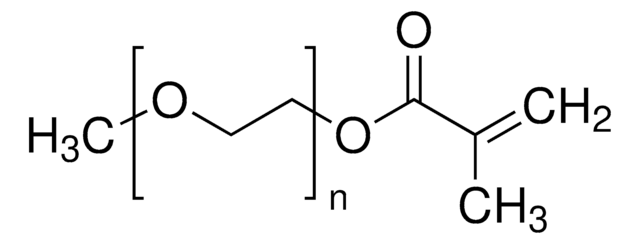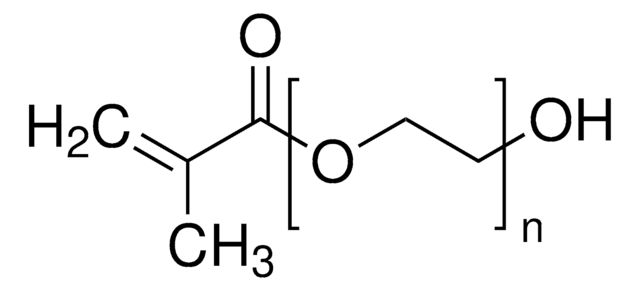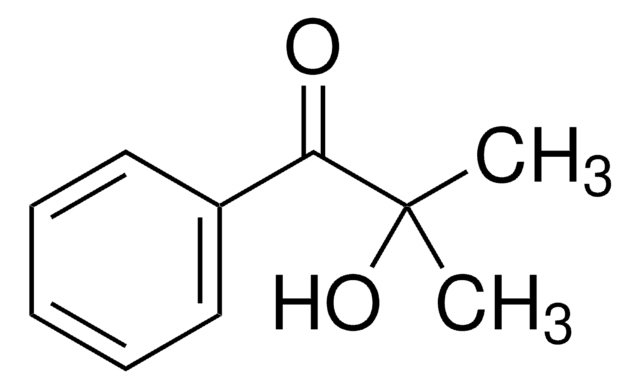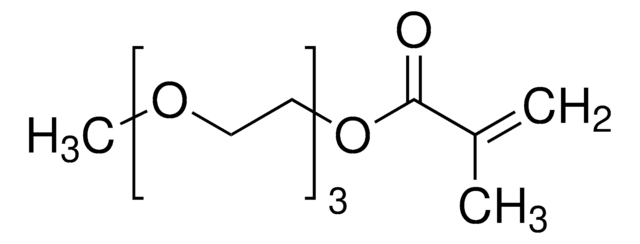Wichtige Dokumente
409537
Poly(ethylenglycol)methacrylat
average Mn 360, methacrylate, 500-800 ppm MEHQ as inhibitor
Synonym(e):
Ethoxyliertes 2-Hydroxyethylmethacrylat, Poly(ethylenoxid)monomethacrylat
About This Item
Empfohlene Produkte
Produktbezeichnung
Poly(ethylenglycol)methacrylat, average Mn 360, contains 500-800 ppm MEHQ as inhibitor
Form
liquid
Qualitätsniveau
Mol-Gew.
average Mn 360
Enthält
500-800 ppm MEHQ as inhibitor
Eignung der Reaktion
reagent type: cross-linking reagent
reaction type: Polymerization Reactions
Brechungsindex
n20/D 1.464
Dichte
1.105 g/mL at 25 °C
Ω-Ende
hydroxyl
α-Ende
methacrylate
Polymerarchitektur
shape: linear
functionality: heterobifunctional
InChI
1S/C6H10O3/c1-5(2)6(8)9-4-3-7/h7H,1,3-4H2,2H3
InChIKey
WOBHKFSMXKNTIM-UHFFFAOYSA-N
Suchen Sie nach ähnlichen Produkten? Aufrufen Leitfaden zum Produktvergleich
Allgemeine Beschreibung
Anwendung
- Abbaubare Mikrosphären mittelsSuspensionspolymerisationsverfahren. Die amphiphile Natur von PEGMA ermöglicht das Durchführender Polymerisation durch direkte Öl-in-Wasser-Suspension.
- Polymere chelatbildende Beads für das wirksameEntfernen von Schwermetallen aus wässrigen Lösungen.
Physikalische Form
Signalwort
Warning
H-Sätze
Gefahreneinstufungen
Skin Irrit. 2
Lagerklassenschlüssel
10 - Combustible liquids
WGK
WGK 3
Flammpunkt (°F)
235.4 °F - closed cup
Flammpunkt (°C)
113 °C - closed cup
Persönliche Schutzausrüstung
Eyeshields, Gloves, type ABEK (EN14387) respirator filter
Hier finden Sie alle aktuellen Versionen:
Besitzen Sie dieses Produkt bereits?
In der Dokumentenbibliothek finden Sie die Dokumentation zu den Produkten, die Sie kürzlich erworben haben.
Kunden haben sich ebenfalls angesehen
Artikel
Progress in biotechnology fields such as tissue engineering and drug delivery is accompanied by an increasing demand for diverse functional biomaterials. One class of biomaterials that has been the subject of intense research interest is hydrogels, because they closely mimic the natural environment of cells, both chemically and physically and therefore can be used as support to grow cells. This article specifically discusses poly(ethylene glycol) (PEG) hydrogels, which are good for biological applications because they do not generally elicit an immune response. PEGs offer a readily available, easy to modify polymer for widespread use in hydrogel fabrication, including 2D and 3D scaffold for tissue culture. The degradable linkages also enable a variety of applications for release of therapeutic agents.
Devising biomaterial scaffolds that are capable of recapitulating critical aspects of the complex extracellular nature of living tissues in a threedimensional (3D) fashion is a challenging requirement in the field of tissue engineering and regenerative medicine.
Unser Team von Wissenschaftlern verfügt über Erfahrung in allen Forschungsbereichen einschließlich Life Science, Materialwissenschaften, chemischer Synthese, Chromatographie, Analytik und vielen mehr..
Setzen Sie sich mit dem technischen Dienst in Verbindung.








